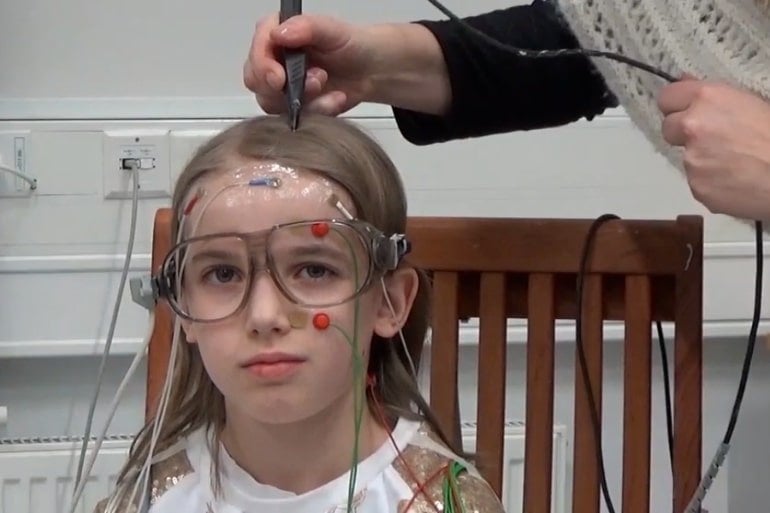Summary: Children at high risk for dyslexia have trouble learning new words after hearing them, a new study reports. Results show those at risk of dyslexia have border difficulties in processing language in the brain, which may account for why reading difficulties occur.
Source: Aalto University
Researchers at Aalto University and the Niilo Mäki Institute have used neuroimaging to pinpoint where the brain activates – or doesn’t activate – among children identified as having a high risk of dyslexia. Magnetoencephalography (MEG) has rarely been used to study the reading disorder in children.
The brain study was carried out at Aalto University by measuring brain activity with MEG, which measures the weak magnetic fields arising from electrical activity in the brain, over a period of two days. Earlier studies have shown that difficulties in processing sounds may be partly responsible for dyslexia, and that these challenges may relate to the left auditory cortex which processes language.
During the study, the children listened to nonsensical four-syllable words from a loudspeaker and were asked to repeat them. The researchers then asked the children if they had heard the word before.
‘The words were nonsense words that really don’t mean anything. We wanted to see how the kids learned to create memories of new words. We noticed that children at a high risk of dyslexia also have deficiencies in learning new words based on hearing them. Their memories of new words were not very precise, and they weren’t capable of differentiating the made-up words from each other. This is an indication of a broader difficulty in processing words in the brain, which makes learning to read more difficult as well’, says Dr Anni Nora, a postdoctoral researcher who developed the MEG measurement test together with Professor Riitta Salmelin and Assistant Professor Hanna Renvall at Aalto University.
Neural activation in the right cerebral hemisphere of the children at a high risk of dyslexia was comparable to that of children in the control group. Problems in processing the sound content of speech, and in learning new words was focused in activity of the left-hemisphere auditory cortex — the area of the brain that specialises in processing language and speech, and where word memory support is located.
‘Considerably less brain activation was found in the left cerebral hemisphere among children at risk of dyslexia. Particularly in children, the processing of language and speech can also be seen in the right hemisphere, but over time the emphasis moves to the left side – each side focuses on more specific tasks as kids grow older. It would be interesting to know if problems with reading and writing are caused by how the cerebral hemispheres specialise,’ Nora adds.

Study participants were in their first and second years of school and had been identified, with the help of a teacher, as high risk. The research team performed neuropsychological examinations, tested reading and writing skills and cognitive abilities, and measured brain functions. The children were also asked about their motivation, including their beliefs about their own reading skills.
Support from tips and feedback
Anomalous brain activity at age 7 or 8 did not completely predict later development of reading; other factors seem to be involved, including a child’s belief in their own ability to learn. The Niilo Mäki Institute studied this further, using tools and tests including a game called GraphoLearn (in Finnish Ekapeli), which is used to teach reading skills to Finnish children.
‘Children were asked to read out both words and meaningless pseudowords that they could not guess. The study also included a part that tested how GraphoLearn affected difficulties in reading and writing.
Generally, playing this learning game did not have a significant effect. But children who were confident about their reading skills got additional benefit from playing the game, and they made better progress in their reading skills than those in the control group. It might be a good idea to develop tools for special education teachers to help them support children’s self-efficacy’, says postdoctoral researcher Miia Ronimus of the Niilo Mäki Institute.
GraphoLearn is a mobile learning game developed at the University of Jyväskylä and the Niilo Mäki Institute. The players connect letters to the sounds of speech and the game adapts to the child’s skill level. Children with the weakest reading and writing skills were selected for the six-week GraphoLearn period. Supervision of the exercise was left to the teachers and parents. Based on the study, features such as tips and verbal feedback were added to the game.
‘The learning game now offers tips on how to improve performance. If a child reacts very quickly, for example, the game might instruct the child to take it easy and slow down,’ Ronimus says.
The research was conducted by a consortium funded by the Academy of Finland. The principal researchers were, in addition to Riitta Salmelin, Professors Heikki Lyytinen from the University of Jyväskylä and Juha Kere from Folkhälsan. The research project began in the autumn of 2015 and took a total of four years. 300 children took part in the reading study, and 35 of them took part in the brain study. Of the children taking part in the brain study, 23 had a high risk of developing dyslexia and 12 read at a normal level.
About this dyslexia research news
Source: Aalto University
Contact: Anni Nora – Aalto University
Image: The image is credited to Aalto University
Original Research: Open access.
“Children at risk for dyslexia show deficient left-hemispheric memory representations for new spoken word forms” by A. Nora et al. NeuroImage
Abstract
Children at risk for dyslexia show deficient left-hemispheric memory representations for new spoken word forms
Developmental dyslexia is a specific learning disorder with impairments in reading and spelling acquisition. Apart from literacy problems, dyslexics show inefficient speech encoding and deficient novel word learning, with underlying problems in phonological processing and learning. These problems have been suggested to be related to deficient specialization of the left hemisphere for language processing.
To examine this possibility, we tracked with magnetoencephalography (MEG) the activation of the bilateral temporal cortices during formation of neural memory traces for new spoken word forms in 7–8-year-old children with high familial dyslexia risk and in controls. The at-risk children improved equally to their peers in overt repetition of recurring new word forms, but were poorer in explicit recognition of the recurring word forms.
Both groups showed reduced activation for the recurring word forms 400–1200 ms after word onset in the right auditory cortex, replicating the results of our previous study on typically developing children (Nora et al., 2017, Children show right-lateralized effects of spoken word-form learning. PLoS ONE 12(2): e0171034). However, only the control group consistently showed a similar reduction of activation for recurring word forms in the left temporal areas.
The results highlight the importance of left-hemispheric phonological processing for efficient phonological representations and its disruption in dyslexia.






